Believe it or not, it's been more than ten years since an offhand tweet birthed the collaboration that would eventually result in this album. Cut to the fall of 2012: Spektral had recently asked me to write a short piece for them, and I was considering adding a vocal part that I would perform myself. Then one day Julia, who I'd been friends with since long before anyone had heard of either of us, happened to be playing Schuba's Tavern in Chicago. We met up for so-so Thai food, and I tweeted that I was hanging out with her for the first time in ages, because back then Twitter was still mainly for that sort of thing rather than hate speech and conspiracy theories. Doyle replied, half-jokingly suggesting that I ask her if she wanted to sing on my piece for the quartet. I did, and she did.
The "Why" of Behind the Wallpaper
Why are we putting out an artist statement? Especially when the story of Behind the Wallpaper stands - dreamily, fantastically, powerfully - on its own?
I wonder, have you noticed this particular dichotomy between the musical world and the visual art world? At concerts, a performer will often introduce a piece of music by sharing a tidbit about a composer, sandwiched between multiple iterations of “and we’re sharing it because it’s some of our favorite music to play.” So, let’s get that part out of the way.
(Cue applause) “This music is some of our favorite music to play!”
Night After Night: A Reflection by Theo Espy
The crackly, old-timey string flourish that begins “Night After Night” (Track 8) is one of my very favorite moments on the album. At this point in the piece the listener is deep within the twists and turns of Alex’s mysterious narrative, and has traversed so many sound worlds and stylistic shifts that reality has begun to blur...
Typically when we’ve approached recording music as a classical string quartet we have found ourselves striving for organicism in the recording/mixing/mastering process, and a natural quality in the “sound” of the recording. Basically, we endeavor to recreate the concert experience with as much fidelity as we can, while polishing some rough corners and creating a delicate balance within the mix that helps each part of the composition shine. For “Behind The Wallpaper” we decided to take a different tack - one that would stretch us, and which we hoped would serve the concepts behind Alex’s compositions and the storytelling of the song cycle. Leaving behind any attachment to “realism” opened many new doors, through which we were shepherded by our brilliant recording team: producer Bill Brittelle and audio engineer Zach Hanson. As we embarked on the mixing and editing process, we allowed ourselves to lean into a purposeful distortion or altering of the materials we came away from the recording studio with. The engineering of the album went from being a subtle and sublimated ‘tool’, to an instrument in its own right. Together with Zach, Bill and Alex we dove into experimenting with filtering, layering, and processing of our sound in a way that would help transport the listener immediately into distinct environments and draw on sonic associations to make that type of auditory teleportation as immediate and as arresting as possible.
Theo Espy in conversation with ‘Behind the Wallpaper’ cover art creator Cat Graffam
TE: Hey Cat! Thanks so much for taking the time to chat. To start us off, can you talk a little about your background and trajectory as an artist, and the process of arriving at your current artistic practice, style, etc?
CG: I arrived at being an artist at a tumultuous time at the end of highschool. I had a lot of trouble at school and home, so entering my senior year I had planned on either dropping out or committing suicide. It was then when I took an art class and my art teacher believed in me and made me apply to art school. Once I found a love for painting in college, I knew that it was going to be my purpose. Art saved my life. My major inspirations stylistically spawned from 20th century painters like Francis Bacon and Kathe Kollwitz. Since then it has evolved, devolved, and changed many times into a more intricate and calmer practice.
TE: Art is absolutely life-saving. I love the way you describe your inspirations both evolving and “devolving” over time - I have definitely witnessed myself experiencing similar patterns with musical influences I’ve had in my past as well. What’s your relationship to music, and does it ever intersect with your practice? Do you listen to music while working? Is this your first time creating artwork specifically to accompany a musical work?
CG: Music is maybe more influential for me than visual art now. Many of the titles of my pieces are bits from songs that I was thinking about or listening to when I created a particular painting. I have done some smaller-scope album covers for friends, but this is certainly the most serious of them!
Classical music needs more pieces like 'Behind the Wallpaper'
Do you read an album’s liner notes?
I do, though in this non-corporeal age of recordings it tends to involve a bit more conscious effort. The outside chance that I’ll encounter a key to unlocking some less-obvious element of the performance, or hell, even just reading an entertaining quip could be likened, for me, to the nervous anticipation of scuffing the foil rectangle on a scratch ticket. It’s thrilling, and the odds are at least better than the Mega Millions.





